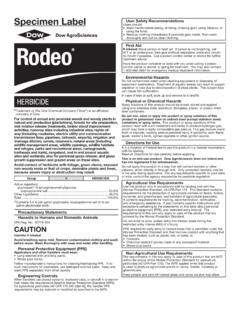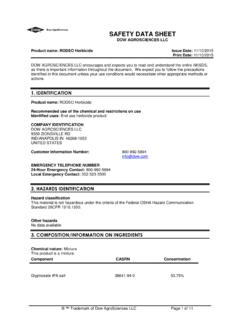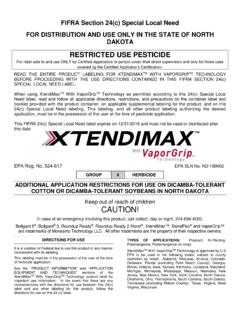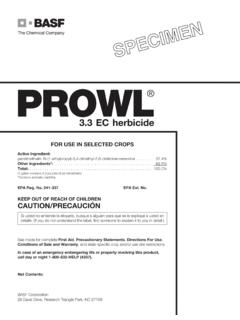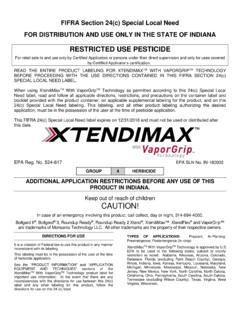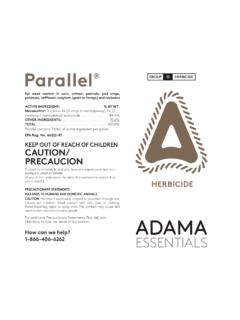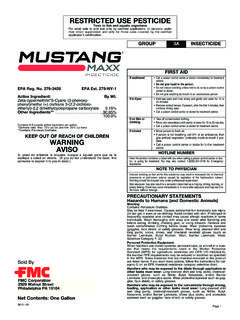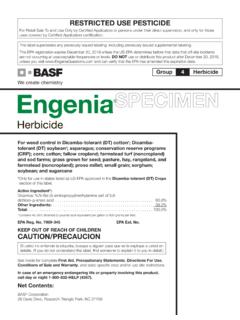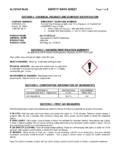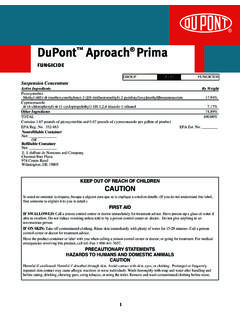Transcription of Specimen Label - CDMS
1 Specimen Label RESTRICTED USE PESTICIDE Due to primary eye irritation study. For retail sale to and use only by Certified Applicators or persons under their direct supervision and only for those uses covered by the Certified Applicator s certification. Active Ingredient: chlorpyrifos: O,O-diethyl O-(3,5,6-trichloro-2-pyridinyl) 50% Other Ingredients .. 50% Total .. 100% EPA Reg. No. 62719-72 Keep Out of Reach of Children DANGER PELIGRO Si usted no entiende la etiqueta, busque a alguien para que se la explique a usted en detalle. (If you do not understand the Label , find someone to explain it to you in detail.) Precautionary Statements Hazards to Humans and Domestic Animals Corrosive Causes Irreversible Eye Damage May Be Fatal If Swallowed Prolonged Or Frequently Repeated Skin Contact May Cause Allergic Reactions In Some Individuals Do not get in eyes or on clothing. Wear protective eyewear (goggles or face shield).
2 Avoid contact with skin. Personal Protective Equipment (PPE) Some materials that are chemical-resistant to this product are barrier laminate, polyethelene, butyl rubber, nitrile rubber, neoprene rubber, natural rubber, polyvinyl chloride (PVC), and viton (all >14 mils). For more information, follow instructions in Supplement Three of PR Notice 93-7. If you want more options, follow the instructions for category A on an EPA chemical-resistance category selection chart. Mixers and loaders must wear: Long-sleeved shirt and long pants Chemical-resistant gloves Shoes plus socks Protective eyewear (goggles or face shield) Chemical-resistant apron All other handlers must wear: Coveralls over long-sleeved shirt and long pants Chemical-resistant gloves Chemical-resistant apron when mixing or loading Chemical-resistant footwear plus socks Protective eyewear (goggles or face shield) Chemical-resistant headgear for overhead exposures A NIOSH-approved dust mist filtering respirator with MSHA/NIOSH approval number prefix TC-21C or a NIOSH-approved respirator with any N, R, P, or HE filter Discard clothing and other absorbent materials that have been drenched or heavily contaminated with this product s concentrate.
3 Do not reuse them. Follow manufacturer s instructions for cleaning/maintaining PPE. If no such instructions for washables exist, use detergent and hot water. Keep and wash PPE separately from other laundry. Engineering Controls Water soluble packets, when used correctly, qualify as a closed mixing/loading system under the Worker Protection Standard (WPS) for agricultural pesticides [40 CFR (d)(4)]. Mixers and loaders using water soluble packets must wear the PPE required above for mixer/loaders, and have immediately available for use in emergency (such as a broken package, spill or equipment breakdown) additional PPE. These PPE include coveralls and chemical-resistant footwear and a NIOSH-approved dust mist filtering respirator with MSHA/NIOSH approval number prefix TC-21C or a NIOSH-approved respirator with any N, R, P, or HE filter. When applicators use closed cab motorized ground equipment in a manner that meets the requirements listed in the WPS for agricultural pesticides [40 CFR (e)(4-6)], the handler PPE requirements may be reduced or modified as specified in the WPS.
4 User Safety Recommendations Users should: Wash hands before eating, drinking, chewing gum, using tobacco, or using the toilet. Remove clothing/PPE immediately if pesticide gets inside. Then wash thoroughly and put on clean clothing. Remove PPE immediately after handling this product. Wash the outside of gloves before removing. As soon as possible, wash thoroughly and change into clean clothing. First Aid Organophosphate If in eyes: Hold eye open and rinse slowly and gently with water for 15-20 minutes. Remove contact lenses, if present, after the first 5 minutes, then continue rinsing eye. Call a poison control center or doctor for treatment advice. If swallowed: Call a poison control center or doctor immediately for treatment advice. Have person sip a glass of water if able to swallow. Do not induce vomiting unless told to do so by a poison control center or doctor. Do not give anything by mouth to an unconscious person.
5 2 Specimen Label Revised 10-07-08 First Aid (Cont.) Note to Physician: Chlorpyrifos is a cholinesterase inhibitor. Treat symptomatically. If exposed, plasma and red blood cell cholinesterase tests may indicate significance of exposure (baseline data are useful). Atropine, only by injection, is the preferable antidote. Oximes, such as 2-PAM/protopam, may be therapeutic if used early; however, use only in conjunction with atropine. In case of severe acute poisoning, use antidote immediately after establishing an open airway and respiration. Note to Physician: Probable mucosal damage may contraindicate the use of gastric lavage. Have the product container or Label with you when calling a poison control center or doctor, or going for treatment. You may also contact 1-800-992-5994 for emergency medical treatment information. Environmental Hazards This pesticide is toxic to fish, aquatic invertebrates, small mammals and birds.
6 Do not apply directly to water, or to areas where surface water is present, or to intertidal areas below the mean high water mark. Drift and runoff may be hazardous to aquatic organisms in water adjacent to treated areas. Do not contaminate water when disposing of equipment washwater or rinsate. This product is highly toxic to bees exposed to direct treatment or residues on blooming crops or weeds. Do not apply this product or allow it to drift to blooming crops or weeds if bees are visiting the treatment area. Notice: Read the entire Label . Use only according to Label directions. Before using this product, read Warranty Disclaimer, Inherent Risks of Use, and Limitation of Remedies elsewhere on this Label . If terms are unacceptable, return at once unopened. In case of emergency endangering health or the environment involving this product, call 1-800-992-5994. If you wish to obtain additional product information, visit our web site at Agricultural Chemical: Do not ship or store with food, feeds, drugs or clothing.
7 Directions for Use It is a violation of Federal law to use this product in a manner inconsistent with its labeling. Read all Directions for Use carefully before applying. This product cannot be reformulated or repackaged into other end- use products. Do not apply this product in a way that will contact workers or other persons, either directly or through drift. Only protected handlers may be in the area during application. For any requirements specific to your state or tribe, consult the agency responsible for pesticide regulation. Agricultural Use Requirements Use this product only in accordance with its labeling and with the Worker Protection Standard, 40 CFR Part 170. This Standard contains requirements for the protection of agricultural workers on farms, forests, nurseries, and greenhouses, and handlers of agricultural pesticides. It contains requirements for training, decontamination, notification, and emergency assistance.
8 It also contains specific instructions and exceptions pertaining to the statements on this Label about personal protective equipment (PPE), and restricted entry interval. The requirements in this box only apply to uses of this product that are covered by the Worker Protection Standard. Do not enter or allow worker entry into treated areas during the restricted entry interval (REI). The REI for each crop is listed in the directions for use associated with each crop. PPE required for early entry into treated areas that is permitted under the Worker Protection Standard and involves contact with anything that has been treated, such as plants, soil, or water, is: Coveralls over short-sleeved shirt and short pants Chemical-resistant gloves made of any waterproof material Chemical-resistant footwear plus socks Chemical-resistant headgear for overhead exposure Notify workers of the application by warning them orally and by posting warning signs at entrances to treated areas.
9 Storage and Disposal Do not contaminate water, food, or feed by storage and disposal. Pesticide Storage: Store in original container in secured dry storage area. Prevent cross-contamination with other pesticides and fertilizers. Do not store above 122 F for extended periods of time. If container is damaged or spill occurs, use product immediately or dispose of product and damaged container as indicated below. Packets may become brittle when stored below 32 F. Handle carefully to avoid breakage. Pesticide Disposal: Wastes resulting from the use of this product must be disposed of on site or at an approved waste disposal facility. Nonrefillable rigid containers 5 gallons or less: Container Reuse: Nonrefillable container. Do not reuse or refill this container. Offer for recycling if available. Triple rinse or pressure rinse container (or equivalent) promptly after emptying. Triple rinse as follows: Empty the remaining contents into application equipment or a mix tank and drain for 10 seconds after the flow begins to drip.
10 Fill the container 1/4 full with water and recap. Shake for 10 seconds. Pour rinsate into application equipment or a mix tank or store rinsate for later use or disposal. Drain for 10 seconds after the flow begins to drip. Repeat this procedure two more times. Pressure rinse as follows: Empty the remaining contents into application equipment or a mix tank and continue to drain for 10 seconds after the flow begins to drip. Hold container upside down over application equipment or mix tank or collect rinsate for later use or disposal. Insert pressure rinsing nozzle in the side of the container, and rinse at about 40 psi for at least 30 seconds. Drain for 10 seconds after the flow begins to drip. 3 Specimen Label Revised 10-07-08 Storage and Disposal (Cont.) Nonrefillable nonrigid containers: Container Reuse: Nonrefillable container. Do not reuse or refill this container. Offer for recycling if available. Refillable rigid containers larger than 5 gal: Container Reuse: Refillable container.
